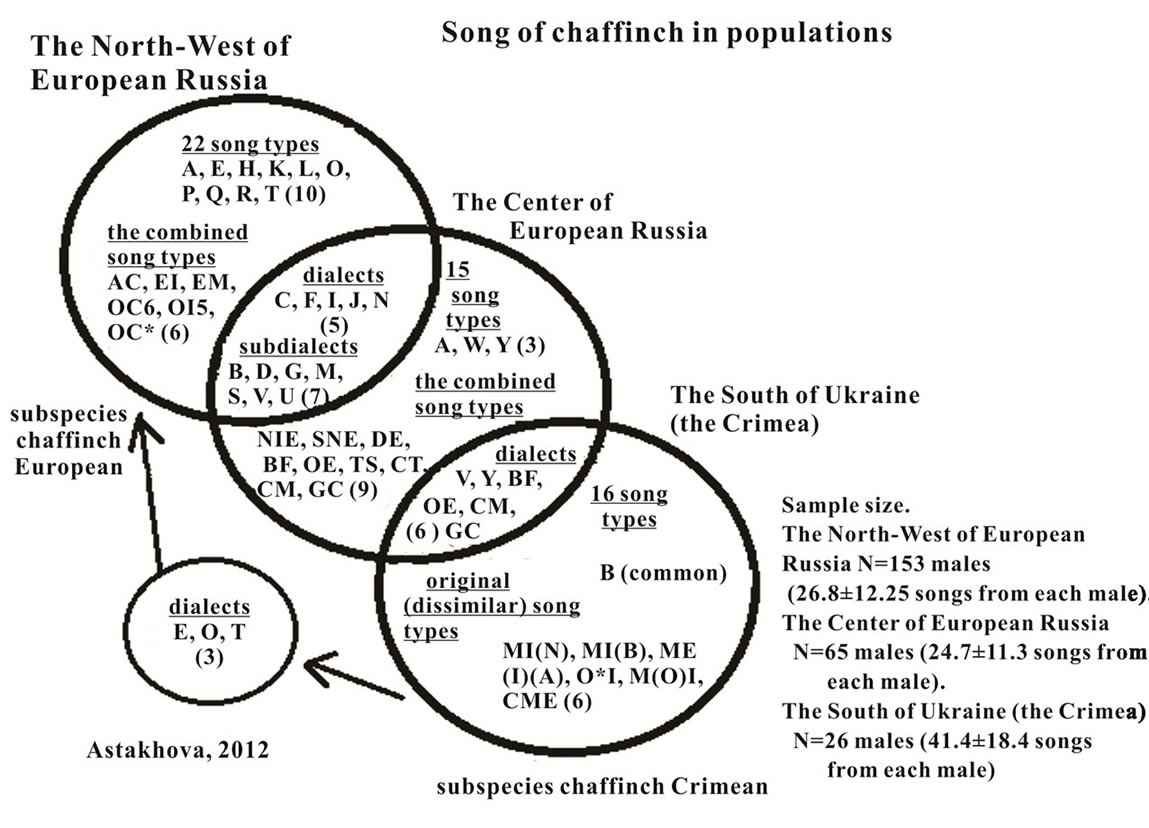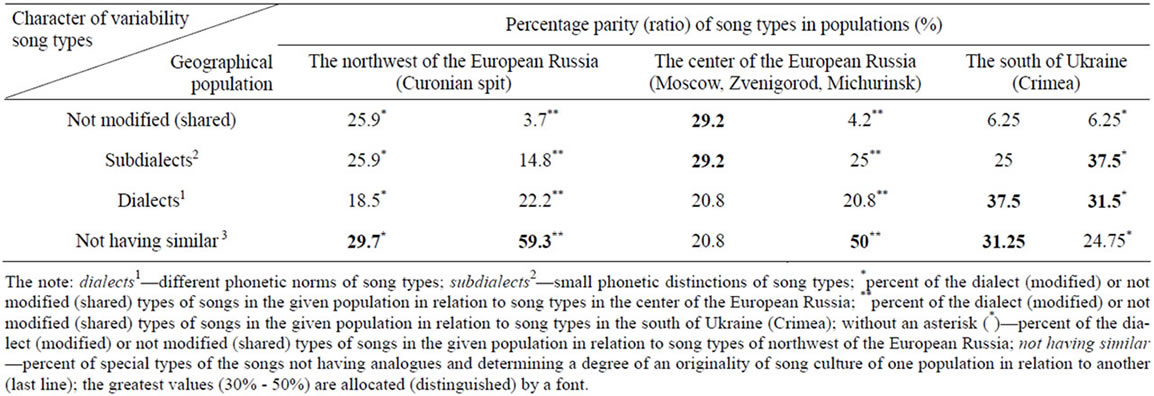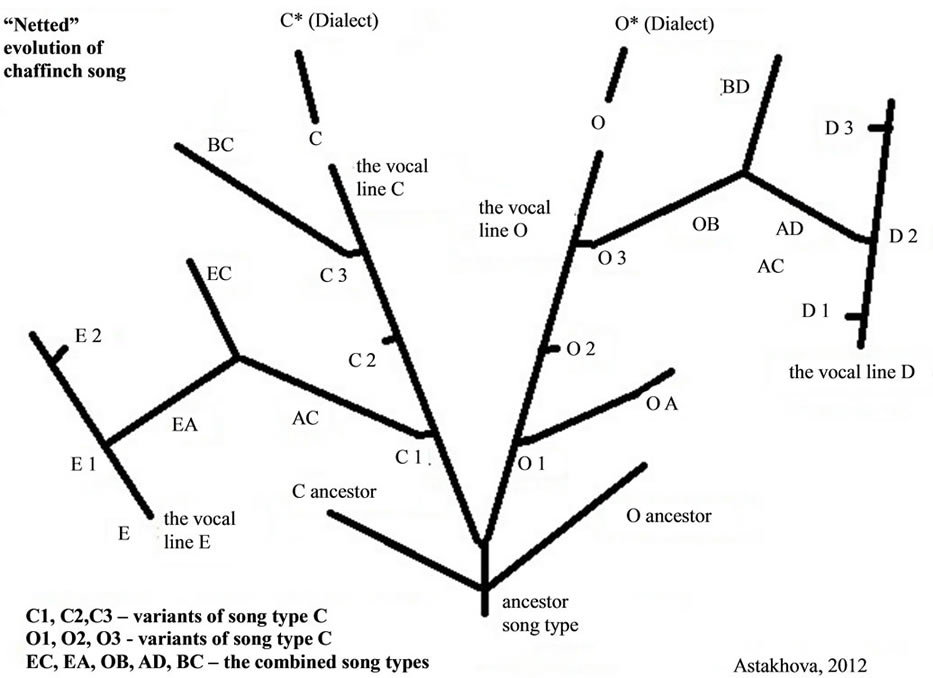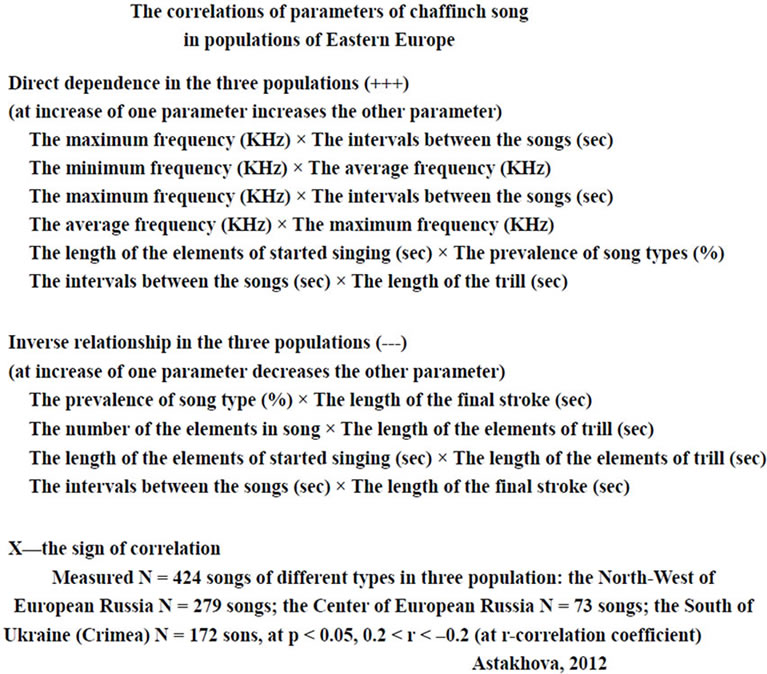Open Journal of Animal Sciences
Vol. 2 No. 4 (2012) , Article ID: 23918 , 6 pages DOI:10.4236/ojas.2012.24029
Chaffinch (Fringilla coelebs L.) song in populations of the East Europe
![]()
Department of Vertebrate Zoology, M. V. Lomonosov Biology Faculty, Moscow State University, Moscow, Russia; chaffinch@bk.ru
Received 7 August 2012; revised 3 September 2012; accepted 14 September 2012
Keywords: Species-Specific Song of Chaffinch; Different Song Types; Song Cultures; Degree of Prevalence of Song Types in Populations
ABSTRACT
Studying of song organizations of chaffinch (Fringilla coelebs L.) are found out to have unique parities of song types in different local populations of a species-specific area. Thus in different areas of the East Europe are forming original (different) song cultures of chaffinch—the certain set of song types including so-called “dialect song forms”. The complex interrelation of geographical variability of chaffinch song in many respects gives a support at an evolutionary view in the given aspect.
1. INTRODUCTION
In many species of sparrow (Passeriformes), males have repertoires from two and more variants of speciesspecific song [1]. Some variants (types) of song are individually various and divided (shared) between individuals of a population [2,3]. According to the proof from many laboratory researches, song type arises through vocal imitation [4]. It is interesting to clear as this process operates in distribution of different song types of chaffinch (Fringilla coelebs L.). Song of chaffinch is genetically determined. The samples of the songs which have been recorded in several local populations of chaffinch are investigated.
Individuals of chaffinch (males) in the repertoire can have 1 - 6 types (variants) of species-specific song. Usually the song of chaffinch will consist of three parts: started singing (it is heard as the row of whistle sounds of high tone), elements of trill (sounds are quickly poured each other and usually are tone hardly lower) and a sharp short stroke at the end [5-7]. Shown the distribution of the song types of chaffinch in the populations of Eastern Europe removed at 1500 - 1800 km.
2. MATERIAL AND METHODS
In northwest (Curonian spit, the Kaliningrad region) and central (Zvenigorod, Moscow, Michurinsk) parts of the European Russia have been made tape recorder records of singing males of chaffinch during the springand-summer period of 2005-2006 (N = 218 males). Different local populations of chaffinch (Fringilla coelebs L.), researched by us, are removed approximately on 1000 km from each other.
Further, sonograms of songs were analyzed with the help of computer program Avisoft-SaSLab Light. In total it has been analyzed about five thousand songs. The songs similar in two or all three parts (started singing, a trill, and a final stroke) we considered as one type. Types of songs were marked by Latin letters.
In May, 2007 in the south of Ukraine (Crimea) (are removed approximately on 1500 km from the European Russia) have been made tape records of singing males of chaffinch, concerning (relate) to separate subspecies is chaffinch crimean (Fringilla coelebs solomkoi Menz.)— sample contained approximately 26 males, from which we tried to fix full song repertoire of each chaffinch individual. The study took place in 2005-2007, but the big conclusions of the research have been made now.
3. RESULTS AND DISCUSSION
Song types of chaffinch distinguished from each other in song structure (syntax), phonetics or a pronunciation of vocal elements, but similar in beat, duration, a way of differentiation on a part, phrases, in the common (similar) frequency range (which appeared stable and, most likely, is genetically determined in all populations of chaffinch as species) [8].
In samples on Curonian spit (the Kaliningrad region) (N = 158 males) we allocate (distinguish) 22 types of song (A B C D E F G H J I K L M N O P Q R S T U V). At record, songs of one type met in different points of territory (was considered, that belong to repertoires of different males), therefore alongside with the letter were designated by numbers in ascending order (for example, А1, А2, А3, etc.).
In populations of the central part of the European Russia (N = 65 males) 15 different types of song (A B C D F G I J M N S U V W Y), of which 12 types of song were similar in the structure to corresponding types on Curonian spit are found, but frequently they had the modified elements on sonograms, therefore were considered as dialect forms (B C D F G I J M N S U V). Local variants of vocalizations of birds can be considered as analogy of human speech and to name “dialects” [9,10]. It has not been found analogues of six song types (H O Е Q R T), and song types W, Y appeared new in relation to known to us song patterns on Curonian spit.
From samples of chaffinch songs in the south of Ukraine (Crimea) (N = 26 males) 16 separate types of songs have been revealed, from which only one song type (В) (6.25%) appeared the common or shared (completely similar) with analogous to it song type in populations of chaffinch in the European Russia. Thus 9 types of songs (56.25%) were the general (common) or shared, but modified (“dialect”) in the general (common) structure and in the form of elements in relation to corresponding (same) types of songs in the European Russia
(song types Е, O, Т (18.75%)—in relation to Curonian spit of Baltic sea (northwest, the Kaliningrad region) and song types V, Y, BF, CM, GC, OE (37.5%)—in relation to the central part of the European Russia (Zvenigorod, Moscow, Michurinsk). The others 6 song types of chaffinch (37.5%) appeared poorly similar (original) in the qualitative aspect (MI (N), MI (B), ME (I) (A), O*I, M (O) I, CME) and are named on phrases (parts) or as a whole of those types of songs, which “reminded” in the structure (the form of elements) (Figure 1).
At the quantitative analysis of chaffinch songs has come to light, that in the south of Ukraine (Crimea) average (median) frequency (КHz) of song types is much higher, than in populations of the European Russia: in northwest (Curonian spit, the Kaliningrad region) (N = 279 of songs) median = 4.10 ± 0.4 КHz, in the central part of the European Russia (Zvenigorod, Moscow, Michurinsk) (N = 73 of songs) median = 4.096 ± 0.29 КHz, in the south of Ukraine (Crimea) (N = 85 songs) median = 4.63 ± 0.23 KHz. Probably, it is connected to warmer climate in the south, which promotes the greater song activity of birds. Thus the minimal and maximal frequency (KHz) of chaffinch songs has remained more

Figure 1. Chaffinch (Fringilla coelebs L.) song in populations of the East Europe.
stable in the values: in northern population (Curonian spit) min = 1.63 ± 0.063 KHz, max = 7.683 ± 0.42 КHz, in the center of the European Russia min = 1.7 ± 0.17 КHz, max = 8.06 ± 0.58 КHz and in a southern population (Crimea) min = 1.85 ± 0.14 KHz, max = 7.98 ± 0.74 КHz. It is necessary to pay attention to length (duration) (sec) of species specific song of chaffinch in different geographical populations: in the north 1.97 ± 0.23 sec, in the center of the European Russia 2.59 ± 0.29 sec, in the south of Ukraine (Crimea) 2.26 ± 0.55 sec (Table 1).
In northern population of chaffinch (Curonian spit) a species specific song are shorter (sec) and lower frequency range (KHz), than in the center of the European Russia and in the south of Ukraine (Crimea). Probably, it is connected by that on the north colder climate, where the metabolism of an organism can be or lower, or pass with the greater economy of expenses of forces (energy) at realization of songs of chaffinch in his (its) northern population.
At the analysis of Table 2 it is possible to draw conclusions:
1) A lot of “dialect” (modified) and “subdialect” (a little modified) in the structure (the form of elements) of general (common) (similar) types of songs were appeared in those local and geographical (more removed) populations of chaffinch (Fringilla coelebs L.), which were in big (closer) communications (connections) among themselves (by migrations—fig. 26, at having of smaller distances of an arrangement to each other). Subdialects of chaffinch song types in the greater degree are found in those populations which are in closer communications (connections) (Figure 1).
2) A lot of subdialects (small phonetic changes) of general (common) song types of chaffinch is found in those populations, which were more contacted to each other (by migrations, smaller distances among themselves (more closely)) and they formed one (uniform) subspecies of chaffinch (Fringilla coelebs coelebs L.). While in less contacted populations of chaffinch (the geographical populations, removed on the big distances— 1500 - 1800 km, can concern or relate to different subspecies of chaffinch) were observed (revealed) a lot of original types of songs (few similar, dialect, not having analogues), determining a degree of “alien” of song cultures (their distinction) at given populations of chaffinch.
3) Originality (allogeneity, distinguish) of song cultures the greatest at those populations which have less communications (connections) among themselves (are most remote from each other): a southern population of chaffinch (south of Ukraine (Crimea))—in relation to northwest (Curonian spit), northwest population—in relation to central in the European Russia, central population of chaffinch—in relation to southern population (as depends on a direction of migratory ways of chaffinch (Fringilla coelebs L.) from one population in another).
Singing of chaffinch (Fringilla coelebs L.)—the feature (sign) is parallelly in the development to others attributes (signs) of this species (morphological, genetic, physiological, ecological, geographical) though, certainly, in many respects together with them forms a single

Table 1. Comparison of basic parameters of song types of chaffinch (Fringilla coelebs L.) in different geographical populations of the East Europe (Astakhova, Byome, 2007).
whole, but, nevertheless, equally with these attributes (signs), a song of chaffinch also develop on the special laws, is differentiated (changes on the basis of initial “ancestors” song forms and “relatives” song lines during time and on space), creates separate steady song norms (set of the most widespread song types), consisting of vocal lines of similar, but also distinguished (different) song variants of one type, forming certain typological vocal polymorphism, from which proceed many other polymorphic branches (or big trunks) of more distant or more close “on relationship” lines of song culture (a variety of song types, a manner or ways of execution (performance) at singing their structure, separate elements, phrases) (Figure 2).
In many literary references in bioacoustics of birds, the view (themes) is described about formation of original (special) vocal traditions of birds in their different local and geographical populations—that is, there is a distinction between sets (complex) of different types of species specific song in the geographical populations, remote from each other. Even if types of species specific song of chaffinch (Fringilla coelebs L.) can differ inside a geographical population in aggregate (set, complex) they are capable to reflect in the structure some features

Table 2. Degree of a generality of chaffinch songs types (Fringilla coelebs L.) in different geographical populations of Europe.

Figure 2. “Netted” evolution of chaffinch song.
of a climate, geology (mountains or plains), character of vegetation of district—and, thus, to form special local culture of vocal (song) (ways of singing of species specific song), distinguished (different) from vocal culture of chaffinch in other geographical population [11-13].
Thus, in different geographical populations of chaffinch (Fringilla coelebs L.) from one generation to next generation can develop (to be formed) distinguished (different) traditions of vocal (song), probably, giving rise (beginning) for new forms (norms) of species specific song or beginning for distinguished (special) vocalizations of new species of birds.
Stability of song culture (set or complex of song types) in a population of chaffinch (Fringilla coelebs L.) during time and on space, probably, is a result of precise or certain (determined) “social” traditions of song learning: training of species specific song by individuals of chaffinch in the first years of a life at singing of grown-ups (older) males, and antiphonal singing (“roll call” by the general (common) songs), the song adaptation (change, transition of plastic song in (to) the stable form) to each other by a generality of song types, by their similarity in “communicative” groups at young males of chaffinch— as between males, having of the same age, at individuals after the first year of a life, and with grown-ups (older) males. Also stability of species specific song is shown as result of selective individual training (copying) of species specific song by individuals of chaffinch in sensitive period at young age (the first year of a life), and also in this case the significant hereditary predefiniteness (determinancy) of parameters of species specific song of chaffinch especially influences (a frequency range and a rhythm, general structure of songs) by genetic inclinations of display (expression) of mentality (psychica) (its(her) rudiments at birds), which is capable to change owing to action of “social” traditions of song learning (“mistakes” of copying) and the individual improvisations in the species specific song (in depending on “creative” potential) of individuals of chaffinch at singing (at realization of types of species specific song) (Figure 3).
4. CONCLUSIONS
Whether the species specific song of chaffinch (Fringilla coelebs L.) is criterion of process of speciation (separation) of species and is a characteristic attribute of subspecies and other formed groups of birds? Probably, as well as any species specific attribute (sign), a song of chaffinch it is capable to be steady at the certain norm, but within the limits of any norm can and vary at individual and geographical variability of individuals in populations, at their special song cultures in aggregate (which represent the original or distinguish set and a parity (ratio) (%) types or variants of species specific song). Thus it is necessary to take into account, that these distinguished (different) song cultures of chaffinch in

Figure 3. The correlations of chaffinch song in populations of Eastern Europe.
different populations will consist of constantly mixing up types of songs of these different populations, where they change or remain constant, being transferred to the following generation.
Geographical variability of song is obvious at many species of birds. The typological parity (ratio), the certain set of song patterns in local populations of birds with the big repertoire (including it is a lot of types of songs) is possible to characterize as mosaic distribution [14], but a number (line, row) of researchers do not support the similar description of bird song variability in territory.
It is possible to track change of bird song from a place to a place and to draw a conclusion, that geographical variability—result of accumulation of mistakes of copying at training of songs (song learning) from generation to generation [15]. But big song repertoires of birds interfere with objective definition of dialect borders within the limits, of which there is a traditional training of song components, characteristic this population [16,17].
In local populations of birds are formed certain (determined) song cultures, which are capable to change in during time and to make vocal dialect forms of birds on all an area of distribution of a species. Steady in time dialects of birds—the phenomenon of conservatism of the vocal traditions, transmitted to the subsequent generations by means of vocal imitation. For many species of bird’s patterns of variability as purchases of vocal traditions is product of cultural evolution.
But when species specific populations are uniform enough and form a single whole—difficultly to speak about formation of separate independent song norms. Most likely, on all a species specific area of distribution of chaffinch (Fringilla coelebs L.) there can be smooth (gradual) transitions from one vocal norm in another or also combination (mix up) of these song norms as a result of migrations of birds, and then there can be a formation of one or several combined song cultures (including cultures of set or many), as occurs in species specific populations of chaffinch (Fringilla coelebs L.), without dependence from to what subspecies it(he) concerns.
It is possible, that more frequently evolution occurs in time, instead of in space—and the species specific song of chaffinch here can be an example. During time, variants or types of song at chaffinch can form the certain variation numbers (lines), phyletical (evolutionary), frequently the crossed, vocal lines, representing more and more new distinguished (different), but also similar vocal forms, also including and former, initial types of songs.
REFERENCES
- Hartshorne, C. (1973) Born to sing. Indiana University Press, Bloomington, 132.
- Slater, P.J.B. (1981) Chaffinch song repertoires: Observations, experiments and a discussion of their significance. Zeitschrift fur Tiërpsychologie, 72, 177-184.
- McGregor, P.K. and Krebs, J.R. (1982) Song types in a population of great tits (Parus major): Their distribution, abundance and acquisition by individuals. Behaviour, 79, 126-152. doi:10.1163/156853982X00210
- Kroodsma, D.E. (1978) Aspects of learning in the ontogeny of bird song: Where, from whom, when, how many, which and how accurately? Burghardt, G. and Bekoff, M., Eds., Garland, New York, 215-230.
- Marler, P. (1952) Variation in the song of the Chaffinch Fringilla coelebs. Ibis, 98, 458-472.
- Thorpe, W.H. (1958) The leaning of song patterns by birds, with especial reference to the song chaffinch Fringilla coelebs. Ibis, 100, 535-570. doi:10.1111/j.1474-919X.1958.tb07960.x
- Nottebohm, F. (1969) The “critical period” for song leaning in birds. Ibis, 111, 386-387. doi:10.1111/j.1474-919X.1969.tb02551.x
- Simkin, G.N. (1983) The typological organization and populational phylogeny of birds song. The bulletin of Moscow society of nature researchers. Section of Biology, 88, 15-27.
- Mundinger, P.C. (1980) Animal cultures and a general theory of cultural evolution. Ethology and Sociobiology, 1, 183-223. doi:10.1016/0162-3095(80)90008-4
- Mundinger, P.C. (1982) Microgeographic and macrogeographic variation in acquired vocalizations of birds. Kroodsma, D.E. and Miller, E.H., Eds., Academic Press, New York, 147-208.
- Thielcke, G. (1969) Geographic variation in bird vocalizations. Hinde, R.A., Ed., Cambridge University Press, London, New York, 311-340.
- Slater, P.J.B. and Ince, S.A. (1979) Cultural evolution in chaffinch song. Behaviour, 71, 146-166. doi:10.1163/156853979X00142
- Slater, P.J.B., Clement, F.A. and Goodfellow, D.J. (1984). Local and regional variations in chaffinch song and the question of dialects. Behaviour, 88, 76-97. doi:10.1163/156853984X00498
- Thielcke, G. (1965) Gesangsgeographische variation des gartenbaumläufers (Certhia brachydactyla) im hinblick auf das artbildungsproblem. Zeitschrift fur Tiërpsychologie, 22, 542-566. doi:10.1111/j.1439-0310.1965.tb01506.x
- Catchpole, С.K. (1995) Bird song: Biological themes and variations. Cambridge University Press, Cambridge, 248.
- Kroodsma, D.E. (1974) Song learning, dialects, and dispersal in the Bewick’s Wren. Tierpsychology, 35, 352-380.
- Kreutzer, M. (1974) Stereotypie et varianttions dans les chants de proclamation territoriale chez le Troglodyte (Troglodytes troglodytes). Reviewer Compared Animals, 8, 270-286.

